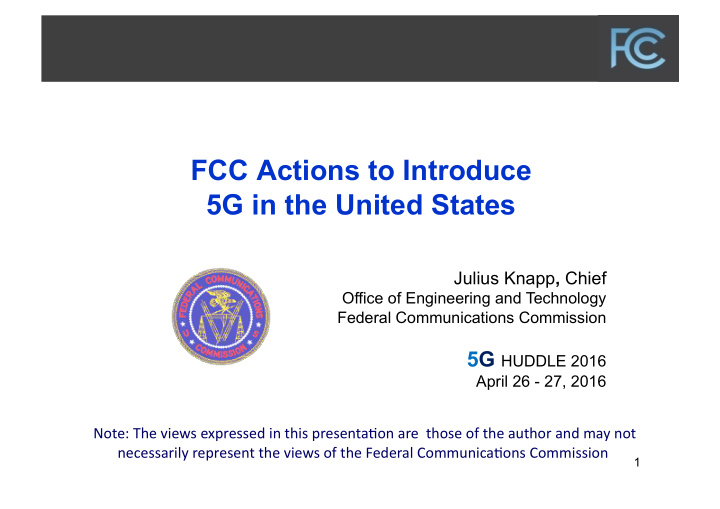



FCC Actions to Introduce 5G in the United States Julius Knapp , Chief Office of Engineering and Technology Federal Communications Commission 5G HUDDLE 2016 April 26 - 27, 2016 ¡Note: ¡The ¡views ¡expressed ¡in ¡this ¡presenta3on ¡are ¡ ¡those ¡of ¡the ¡author ¡and ¡may ¡not ¡ necessarily ¡represent ¡the ¡views ¡of ¡the ¡Federal ¡Communica3ons ¡Commission ¡ 1
FCC Approach to 5G Remarks of FCC Chairman Tom Wheeler at March 8, 2016 Satellite Leadership Dinner: “The United States approaches the kind of opportunity 5G presents somewhat differently from other countries. We do it by indicating which spectrum will be made available and then relying on a private sector-led process for producing technical standards best suited for those frequencies. We won’t wait for the standards to be first developed in the sometimes arduous standards-setting process or in a government-led activity.” “Last summer, the Commission launched what we call our Spectrum Frontiers rulemaking to explore the use of millimeter wave spectrum – the airwaves at 24 GHz and above – for 5G. Our Spectrum Frontiers rulemaking reflects the need to be innovative and flexible in how we utilize spectrum. We cannot limit ourselves to old models or worst-case analyses.” 2
5G – Policy Perspective 5G is a national priority for US We indicate which spectrum will be made available Rely on a private sector-lead process for producing technical standards best suited for those frequencies Flexible licensing rules to support various service models Carrier-driven vs. new entrant vs. end-user driven network Technical rules to take advantage of propagation characteristics of mmW bands Enable sharing opportunities Enhance spectrum reuse Create opportunities for innovators to build and deliver new services and applications to consumers 3
Key Events FCC Spectrum Frontiers Notice of Proposed Rulemaking (NPRM) Released on October 23, 2015 Comments and Reply Comment were due on Jan 26 th and Feb 23 rd , 2016 WRC15 Identified 11 bands to study for 5G in WRC19 Not all of Spectrum Frontiers NPRM bands are aligned with WRC15 study bands 2016 MWC in Barcelona 5G took a center stage FCC 5G Workshop One-day workshop on April 10 th , 2016 Panel discussions on key topics with industry leaders Latest 5G equipment were demonstrated 4
Spectrum Frontiers NPRM Core Principles Identify substantial spectrum in MMW bands for new services Protect incumbent services against interference Flexible use: Enable market to determine highest valued use Overlay auctions where no existing assignments Provide spectrum for both licensed and unlicensed use Ensure cyber security protections are considered from the start Frequency Bands Proposed 27.5-28.35 GHz; 38.6-40 GHz; 37-38.6 GHz; 64-71 GHz Invited comment on 24.25-24.45 GHz; 25.05-25.25 GHz; 29.1-29.25 GHz; 31-31.3 GHz; 31.8-33 GHz; 42-42.5 GHz; 71-76 GHz; 81-86+ GHz Licensing, Operating and Regulatory Rules/Issues Part 30: Upper Microwave Flexible Use Service (UMFUS) Geographic Area Licensing, Area Size, Band Plan, License Term Technical rules Performance Requirements Further NPRM planned post-WRC 5
Overview of Proposed Bands 28 GHz 37 GHz 39 GHz 64-71 GHz Frequency 27.5-28.35 GHz 37-38.6 GHz 38.6-40 GHz 64-71 GHz Bandwidth 850 MHz 1600 MHz 1400 MHz 7000 MHz Terrestrial Licensed for fixed Yes (no current use) Licensed for fixed Yes (no current use) Allocation operations, with about operations, with about 75% of the population 50% of the population covered by existing covered by existing licenses; remaining licenses; the licenses in inventory remaining licenses are in inventory. Federal No Radio Astronomy / Fixed Satellite Earth Exploration Allocation Space Research in Service / Mobile Satellite 37-38 GHz @ 3 sites; Satellite Service in 39.5-40 (military use Fixed/Mobile/Satellite Federal Fixed/Mobile only) in 37-38.6 GHz @ 14 locations Satellite Yes Yes (no current use) Yes (no current use) Yes (no current use) Allocation Secondary E-S Proposed Licensed Licensed Licensed Unlicensed Licensing
Some Factors Enabling Sharing • High amount of spectrum provides flexibility to avoid interference • Relatively high path loss • Adaptive antenna Full Dimensional MIMO technology (steered beams) • Heterogeneous networks 5G Deployment Scenario 7
Proposed Technical Rules Flexible Duplexing TDD and/or FDD TX Power Max EIRP of 62dBm/100MHz is proposed for BS Max EIRP of 43dBm is proposed for MS Sought comments on the bandwidth factor for mmW band technologies Out of Band Emissions (OOBE) Radiated measurement is assumed due to lack of RF port 43+10logP is proposed and sought comments on the measurement bandwidth, offset and other parameters as applicable from existing FCC rules Field Strength at Market Borders Sought comments on the applicability of 47dBuV/m per Part 27 rules Measurement Techniques Sought comments on measurement challenges of mmW bands, particularly on the radiated measurement techniques 8
FCC 5G Workshop - Service Vision 9
FCC 5G Workshop - Equipment Demos
5G Technology Status Source: https://www.fcc.gov/news-events/events/2016/03/spectrum-frontiers-workshop 11
Next Steps NPRM enjoys strong support Suppliers have developed equipment Carriers are conducting tests & planning trials Work is proceeding to fine tune proposals Satellite and Wireless industries collaborating to develop sharing framework Developing incumbent protections FCC plans to act this summer Will identify spectrum & adopt rules for 5G Will propose or consider additional spectrum (including WRC bands) FCC action is not at odds with international harmonization R esearch by government and industry is ongoing 12
Thank You 13
Recommend
More recommend